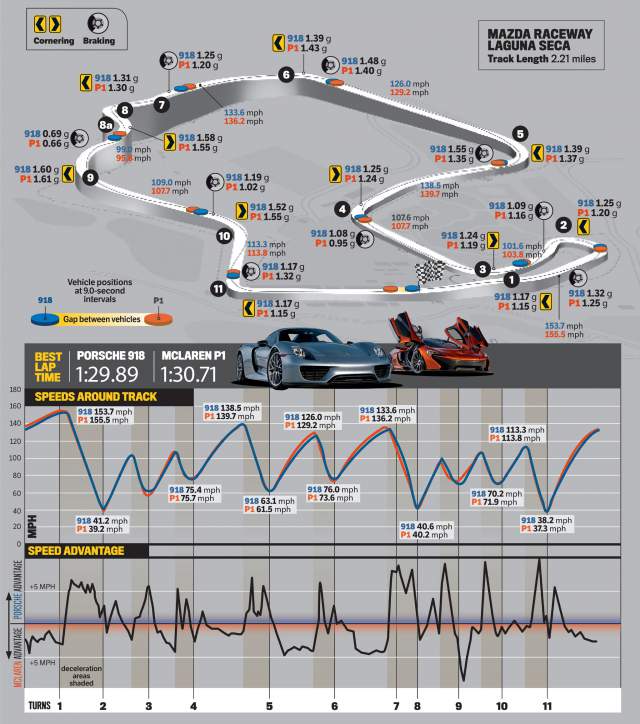Porsche 918 Spyder Beats McLaren P1 at Laguna Seca
With a 6:57 lap around the Nurburgring Nordschleife, the Porsche 918 Spyder is the world’s fastest globally homologated production car around the famed German circuit. While no official lap time has been released for the McLaren P1, the British marque reports it has lapped ‘Green Hell’ in less than 7 minutes. Which of these two hybrid hypercars however is fastest around another well-known racetrack, in this case Mazda Raceway Laguna Seca? Well Motor Trend set about to answer that and here are the results.
When the Porsche 918 Spyder hit the famous North American circuit, a potent lap time of 1:29.89 was set when fitted with the standard Michelin Pilot Super Cup 2 tyres. That record lap was set on the very first try after one warm up lap and one charging lap.
By comparison, 8 laps in total were completed by the McLaren P1. They included a warm up lap, charging lap, record attempt lap, charging lap, record lap, charging lap, record attempt lap and the final lap. In the second record lap attempt, a best time of 1:30.71 was set. This McLaren P1 in question was fitted with Pirelli P Zero Trofeo R tyres – the most aggressive tyres available for the British hypercar. The P1’s tyres also came heat-cycled while the 918 Spyder’s didn’t making the German car’s lap time all the more impressive.
It seems apparent from these results that the all-wheel drive system and the advanced torque vectoring system of the 918 Spyder benefits it greatly on the race track. It is also more than enough to offset the additional 150 kg of weight the 918 carries compared to the P1.
On paper, the McLaren P1’s 3.8-litre twin-turbocharged V8 engine delivers 903 hp meaning it will travel from zero to 100km/h in less than 3 seconds, zero to 200km/h in under 7 seconds, and zero to 300km/h in no more than 17 seconds.
By comparison, the Porsche 918 Spyder uses a mid-mounted 4.6-litre V8 engine producing 608 hp independently – the highest specific power of any naturally aspirated Porsche engine. The V8 is then supplemented by a further two electric motors mounted on each axle. The electric motors can either drive the wheels independently or work together with the engine to boost performance. Each motor produces enough power to boost the total figure to an amazing 887 hp.
Trending Posts
- The 1 of 1 Ford Raptor 6x6 Fitted with Terra Bronze Vossen...
- Aston Martin Vanquish S Volante: The Sexiest Convertible...
- 2021 Range Rover Velar R-Dynamic HSE in Santorini Black !
- Mini Cooper Jcw At Vs. Audi S1 Quattro
- Distild Black On Black Audi A5 !
- Ford Focus RS to Compete in 2016 FIA World Rallycross
- Black & Yellow Rolls Royce Wraith Special Luxury
- Audi RS4 Mud Drifting and Revving, Brutal Sound










